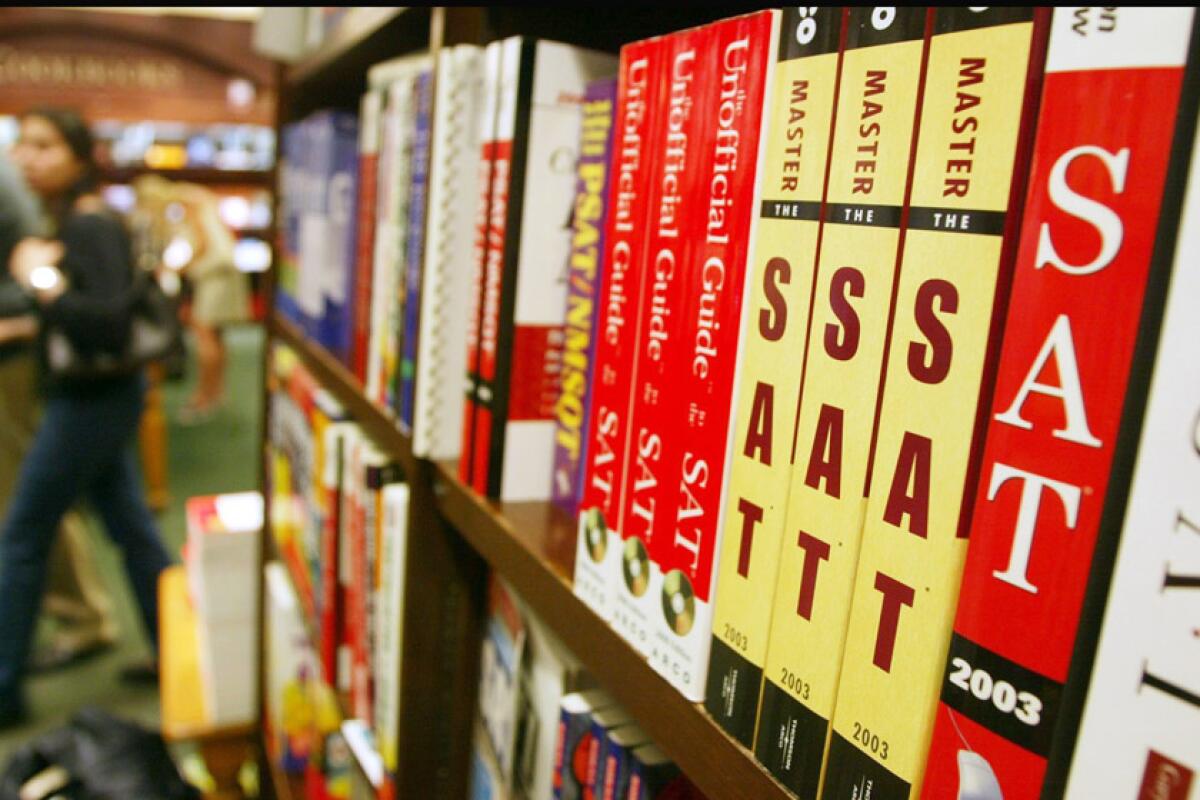For first time, L.A. schools have free SAT day for all juniors

The Los Angeles school district has focused in recent years on boosting high-school graduation rates and sending more students to college. This month, it has taken a big step by having all juniors take the SAT, a standardized college admissions test, on a school day, for free.
It’s not lost on district officials that they are rolling out an initiative to improve college access at a time when the news is full of stories about wealthy people cheating to get their children into top schools.
About 4 in 5 L.A. Unified students are minorities from low-income families. Many would be the first in their families to attend, or graduate from, college.
“Recent news has reminded us just how inequitable access to higher education has been in our country for low-income students and children of color,” said board member Kelly Gonez, who proposed the SAT plan. By integrating the SAT into a school day, “we are opening the door to higher education wider so that more students have the chance to pursue their dreams.”
L.A. Unified is picking up the tab for the juniors’ tests. The district negotiated a reduced rate, $1.2 million for all the students, with the College Board, the organization that administers the test.
But it wasn’t just the regular $64.50 fee that had been a burden for some district families. Getting to unfamiliar testing sites on Saturdays also posed transportation challenges for many.
Most four-year colleges require applicants to take either the SAT or the ACT. Experts recommend giving the tests a first try during junior year. In L.A. Unified, fewer than half of juniors have been doing so. Now the district — to give them a push — is requiring that they all do.
The college admissions scandal has exposed parents who paid enormous sums to have ringers take the tests for their children. Some gamed the system by having their children improperly diagnosed with learning disabilities to get them extended time to take the tests.
Families with means, of course, also have other advantages, including the ability to pay for test preparation courses that can boost students’ test scores.
At Reseda High School in the San Fernando Valley, where 340 juniors took the test this week, the district also was doing its best to close the gap on the test prep front.
Students have been encouraged to log on — at school or at home — to the Khan Academy, which is free and offers practice tests that help them identify the areas where they need more practice.
The week before testing, all juniors also attended sessions to learn test-taking tips.
Reseda High also used grant money to hire a district-recommended firm to provide additional test prep for students. Those who signed up met on Saturdays for four hours at a time for about a month, said Principal Melanie Welsh. About 45 students took advantage of help that would usually cost $1,500 to $2,000. Welsh hopes more will sign up next year.
Maria Gutierrez, an immigrant from El Salvador, is still working on her English and said she learned how to focus her reading. Now, she said, she looks at a passage and immediately tries to pull out the key points from each paragraph and connect each to a main idea.
“We have to find a strategy to go against the time the SAT has provided to us,” she said. “You have a lot of work to do and you don’t have enough time to finish completely and do well.”
The math and reading portion of the test takes about three hours. The optional essay adds another hour.
Even though she’s in precalculus, Gia Johnson said she needed the Khan Academy tools to brush up on math skills that appear on the SAT. She also appreciates the test not being on a Saturday, given that her schedule already is packed with math club and the soccer team and advanced classes that include much homework. She’s also the leader of the science bowl team, captain of girls volleyball and team manager for boys volleyball.
Taking the test at school during the school day was “a giant relief,” Gia said.
The district’s deal with the College Board allows low-income students to take the SAT twice more for free and send eight score reports to colleges at no cost.
The New York City school district is among those nationwide that offer the SAT free to all juniors, though taking the test isn’t mandatory there. Similar efforts are beginning to take hold across California. In some states, the ACT or SAT has become a high school graduation requirement.
Gia said her best friend hadn’t planned to take the SAT. “She said she doesn’t see the point in going to college. She wasn’t into it and spent a few days trying to figure out how to get out of it. Then, she hunkered down and started to prepare. She got pretty excited about it.”
Welsh loved that story.
“They may push back but then they get on the bandwagon,” the Reseda High principal said. “For that student, we really met our goal.”
More to Read
Sign up for Essential California
The most important California stories and recommendations in your inbox every morning.
You may occasionally receive promotional content from the Los Angeles Times.











